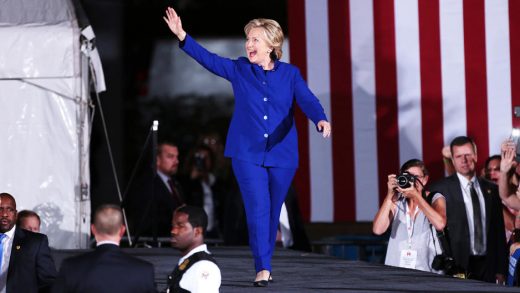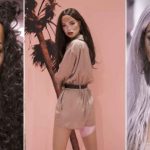The Year Fashion Collided With Politics
Fashion has been accused of being frivolous and inconsequential, but this year, it played a significant role in our culture, beyond a visual means of self-expression. During a stressful, caustic, and divisive election, fashion became a locus of community for people on opposite sides of the political spectrum and served as a vehicle for people to peacefully express their views.
Over the last year, when tensions ran high and emotions were raw, fashion sometimes brought some civility back into everyday life. This was true at Stella & Dot, a jewelry and accessories brand that sells products through 50,000 independent business owners who host trunk shows in their home. The headquarters are located in the liberal cities of San Francisco and New York; cofounder and chief creative officer Blythe Harris was surprised to find that Stella & Dot’s sellers and customers—who are spread out throughout the country—were evenly split in their political leanings.

During the campaign, the media often described how people were stuck in echo chambers of their own point of view, but this was not Harris’s experience. In the course of everyday business affairs, she found herself regularly calling or emailing Stella & Dot coworkers or consumers who had radically different political values than her own. She realized everyone in the company needed to be self-aware and sensitive when discussing the election because there was a good chance the person they were speaking with had very different ideas about what was best for the country. For Harris, this was a positive experience: It trained people to be more sensitive, empathetic, and open-minded. “You had to reframe how you’re thinking about things,” she says. “It was not some vague person in the Rust Belt that you might never come into contact with. You know these people: They are the people right next to you, working hand in hand.”
While some brands came out in support of Hillary Clinton, Harris felt that it was important for Stella & Dot to remain neutral—and not just to avoid alienating customers. She decided to make the site a place where people could feel connected with one another, rather than pulled apart by politics. On Stella & Dot’s Instagram account, for instance, there were no overtly political posts, which meant there weren’t strings of angry comments from Clinton and Trump supporters fighting among themselves—a common occurrence in the run-up to the election. “In the end, I was grateful to be part of a community where people were not so divided in terms of their preference,” Harris says.
The founders of women’s workwear brand MM.Lafleur also wanted to use their platform to foster community. But rather than staying apolitical, they chose to take an overtly political approach. Two days after the election, when many people were feeling confused and disheartened by the results, CEO Sarah Lafleur sent an email to customers on the company’s mailing list to invite them to share their thoughts and feelings about what had just transpired. Her memo included these thoughts:
As a brand, we exist because we believe that professional women are an overlooked and underserved group. We have always been proud to dress women of all political persuasions, and we staunchly believe that women are most powerful when we come together to support one another.
As a brand, we are not apolitical—how can anyone be?—but we are open-minded, empathetic, and determined to pursue a meaningful conversation with women of all backgrounds and viewpoints. We’re choosing to move forward with hope, optimism, and openness as we pursue our mission of championing and uplifting all professional women.
Now, as ever, we welcome your input on how we can best support you in all that you do.
The email led to a flood of more than 1,100 responses from customers. A few were angry that MM.Lafleur was bringing up politics at all. “You’re a clothing brand,” one said. “You should stay out of politics.” But this didn’t dissuade Lafleur and her staff. And many other customers were grateful for the opportunity to unload their emotions and engage with other women whose views spanned the gamut. “The excessive, overly dramatic response to what was a fair election is absolutely absurd,” one customer wrote. “And for the record, no, I did not vote for Trump. I voted for Hillary. I am just choosing to afford my fellow Americans some respect.” Another said, “I am having a difficult time dealing with the idea that a man who is on record as insulting, degrading, and boasting of the sexual assault of women is soon to be my commander-in-chief. It makes me feel unimportant, unheard, and powerless.”

MM.Lafleur is learning from these insights. The company’s leaders believe that they have a voice and an audience, and are in a position to use their platform to change culture and policy. On its blog, newsletter, and advertising materials, the company’s editor-in-chief Tory Hoen has explained that she wants MM.Lafleur to take a stand on issues such as gender imbalances in the C-suite and the rights of disabled women in the workplace. “In other words, we’re as much a media company as we are a clothing brand—and we find that our product and our content reinforce one another,” Hoen says via email.
But at every turn, MM.Lafleur is making sure that it’s focused on issues that matter to its core customers: high-achieving, career-focused women. “We use our platform to spark conversation and advocate on behalf of ‘our woman,'” Hoen says. She points out that this is not just important from a civic perspective; it also drives interest and clicks to the website. “Though we also talk about our products and do content around styling, we find that our more controversial content gets the most engagement and drives the most discussion,” she says.
Hoen has already used the blog to take the New York Times to task for an article it published that, in her opinion, did not accurately reflect the double standard that men and women face when it comes to dressing for work. “Increasingly flexible dress codes do not mean that women will automatically devolve into wearing T-shirts and sweatpants to work,” Hoen wrote. “To wit: Sheryl Sandberg does not show up for work in a gray T-shirt and jeans, but rather, chooses an elegant uniform of tailored dresses and smart separates.” She has also published interviews with disability-rights advocate Danielle Sheypuk and Make Love Not Porn founder Cindy Gallop. Given the change in political leadership and the potential erosion of women’s rights, Hoen wants to put out even more of what she calls “activist content.”
MM.Lafleur’s stance on addressing politics directly was reflected in the fashion industry as a whole. Vogue reserved a full page in its magazine to endorse Hillary Clinton, the first presidential endorsement the magazine has made in its 100-year history. The nation’s top fashion designers also came out in support of Clinton. Diane von Furstenberg, Prabal Gurung, Marc Jacobs, and Tory Burch created T-shirts for her campaign’s web stores. Many also hosted fundraisers for her. After the third presidential debate, where Trump called Clinton a “nasty woman” and referred to some Mexicans as “bad hombres,” Bob Bland, the CEO of fashion incubator Manufacture New York, quickly created “nasty woman” and “bad hombre” T-shirts, donating all proceeds to Planned Parenthood.

And on the consumer side, there was a grassroots movement of people showing their support of Clinton with their clothing. While people have expressed their political views through T-shirts and buttons for decades, this year, millions of women—and even some men—went a step further by going to the polls dressed in pantsuits, Clinton’s uniform of choice. This created a viral meme on social media as they posted pictures of themselves together with the hashtag #PantsuitNation.
And some designers are planning on continuing to use clothing as a tool of protest and education. Take Abe Burmeister, cofounder of menswear company Outlier. His brand had always been apolitical, but these days, he’s eager to come up with ways of using his business as a platform to help activist organizations spread their message. As he sees it, fashion companies have a unique platform to make bold statements that could start trends and keep the dialogue flowing.
“I donated to a few groups after the election and was reminded just how bad their merchandizing options are,” Burmeister says. “I want an ACLU hoodie that looks sharper and speaks louder than Vetements! And truthfully, designers could gain a lot by working with some more serious organizations, while those organizations can sometimes use some help in communicating their messages wider.”
Burmeister also wants to create clothes that reflect his vision of the U.S., one that welcomes immigrants and is not nationalistic. This could manifest itself in obvious ways, like incorporating influences from other cultures into new collections to ensuring that ads reflect a diverse range of faces. But Burdemeister is also excited about other creative ways to reflect an open multicultural America that he hasn’t even imagined yet. “Anything that can communicate post-national and unified diversity will find a welcome audience, but who knows what that will be,” he says.
Fashion designers are now thinking about how to create garments that send a message in this new political climate. We’ll have to wait and see what they come up with, but to quote Elsa Schiaparelli, an Italian designer who rose to prominence between the World Wars, “In difficult times, fashion is always outrageous.”
Fast Company , Read Full Story
(39)














